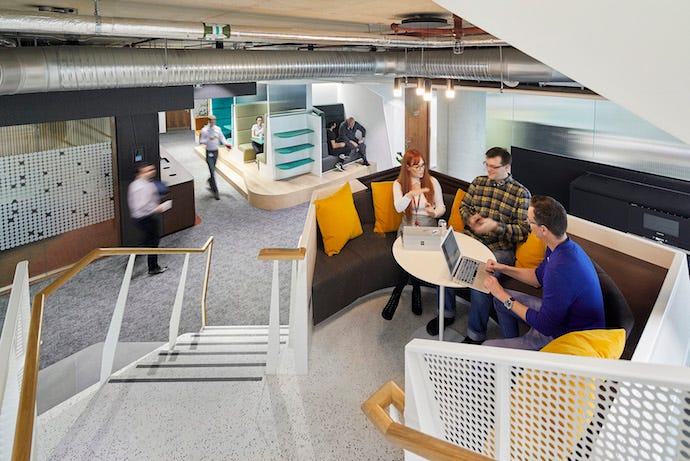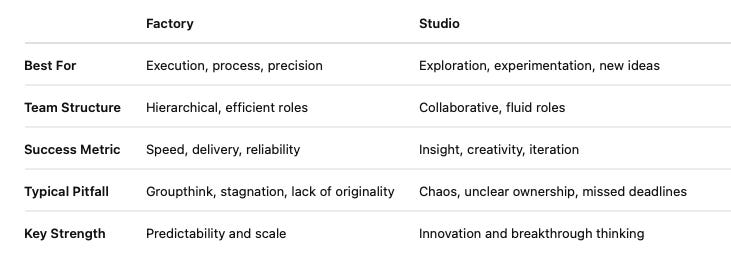Factory vs. Studio: Why Most Teams Pick the Wrong Mode to Innovate
💥 Creative Capacity isn’t just about talent. It’s about environment.
A few months ago, I walked through Capital One’s Product Innovation Lab in McLean, Virginia.
There wasn’t a “design aesthetic.” There were design environments.
One space looked like a startup co-working loft, with whiteboards, breakout pods, and writable walls.
Another was structured like a customer journey map, with friction points spread across the wall.
A third felt like a war room for a product launch… structured, process-driven, and optimized for execution.
What struck me wasn’t just how cool the spaces were. It was that each space matched the type of work a team needed to do.
One was built for creativity.
One for exploration.
One for decision-making and delivery.
Most companies don’t think this way.
They set up one environment… physical or digital… and expect it to support all kinds of work.
🚨 The Real Problem with the Remote Work Debate
Lately, there’s been a hard push from big companies to bring people “back to the office.”
The narrative: We need collaboration. We need innovation. We need the hallway moments back.
But here’s the problem…
Most offices weren’t designed to foster innovation.
And most teams didn’t know how to structure for creativity before remote work either.
The issue isn’t remote or in-person.
The issue is how we design the working conditions for the type of output we want.
Remote work doesn’t kill innovation.
But rigid, prescriptive work environments do.
🧠 Why Creative Capacity Requires Agency
We’ve been researching Creative Capacity inside teams… what actually drives innovation, experimentation, and follow-through.
We discovered something big:
Creative Capacity isn’t a personality trait. It’s an environmental outcome.
When people have:
The agency to operate with some autonomy,
The structure to know what success looks like,
The space to think differently,
And the support to try bold things…
That’s when creativity becomes action.
That’s when innovation becomes a habit.
🛠️ Factory vs. Studio: Are You Using the Wrong Work Mode?
Here’s a simple framework I teach in my workshops:
The key insight?
Most teams are stuck in Factory Mode when they need to be in Studio Mode… and vice versa.
The solution isn’t “change your whole culture.”
It’s about matching the mode to the moment.
Start Condition design is the single most underused leadership skill in corporate innovation.
🧠 What Mode Does Your Project Need?
Take this 2-minute quiz to determine if your team should be in Factory Mode (structured, execution-focused) or Studio Mode (exploratory, adaptive).
1. What is the clarity of your project goal?
A. We have a clearly defined outcome, KPI, or deliverable. (Factory)
B. We’re still exploring the opportunity, problem, or path forward. (Studio)
2. How well understood is the solution space?
A. We’ve done this (or something similar) before and know what works. (Factory)
B. It’s unclear what will work—we need to experiment or invent. (Studio)
3. What’s the level of organizational support or pressure?
A. There’s executive buy-in, timelines, and expectations. (Factory)
B. We’re flying under the radar or have space to explore. (Studio)
4. What kind of team do you have?
A. Cross-functional roles are clearly defined with specialized execution. (Factory)
B. We’re wearing multiple hats and figuring it out as we go. (Studio)
5. What’s your timeline?
A. We’re delivering against a roadmap or deadline. (Factory)
B. We’re exploring options and evolving based on what we learn. (Studio)
6. How much iteration is expected?
A. We’ll improve post-launch but don’t expect major pivots. (Factory)
B. We’ll probably change direction based on feedback and testing. (Studio)
🧩 Your Results
4–6 “A” answers? → You’re in Factory Mode. You need structure, process, and execution discipline.
4–6 “B” answers? → You’re in Studio Mode. You need space, iteration, and idea development.
Mixed? → You likely need a Hybrid Mode: start in Studio to explore, then shift into Factory to scale and execute.
The Bottom Line
Creative Capacity is the new competitive advantage.
But it doesn’t come from talent alone.
It comes from designing the right conditions.
It’s not about fully remote or fully in-office.
It’s not about more collaboration or more focus time.
It’s about choosing the right mode for the work.
And that starts with you.
—
If you’re a team leader, HR exec, or manager building a more creative, productive, and innovative team, I run custom workshops, keynotes, and hands-on innovation trainings to help boost your team’s Creative Capacity.
🎤 Topics include:
Unlocking Innovation with Studio Thinking
How to Design Better Start Conditions for Creative Teams
The Creative Capacity Playbook: From Ideas to Execution
Let’s stop trying to do more.
Let’s start designing to create more.
—
Eric Koester
Georgetown Professor | Author | Innovation Trainer
Creative Capacity Newsletter





